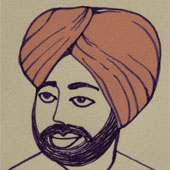In this age of reason and rationality it becomes essential to know ‘why’ and ‘how’ turban helps in our spiritual evolution. Turbans go way back in history as part of a spiritual practice. In this age of reason and rationality it becomes essential to know ‘why’ and ‘how’ turban helps in our spiritual evolution. Turbans go way back in history as part of a spiritual practice.
In case of infants, these bones are still not fused together and at the top of the head - if you observe closely. You will find a ‘soft spot’ which pulsates in synchronization with the heartbeats. In yogic terms, this spot is referred to as ‘Crown Chakra’. Thousands of years ago our seers, sages and spiritual persons (Rishis, Munis and Yogis) discovered that the hair on the top of the head protects the ‘crown chakra’ from the sun and exposure to various undesirable environmental elements. In addition, the hair acts as antennae, channelling the solar energy and its life force into the body and brain.’ By the Kalgidhar Trust/ Society, Preserving Turban.
Thus, spiritual persons (Rishis, Munis and Yogis) would coil or knot their hair at the ‘crown chakra’ also called the ‘solar centre’ of the head. This centre is on the top and the front of the head in men (anterior fontanel). Women are said to have two solar centers: One at the anterior fontanel and the other at the posterior fontanel which is at the back of the head. The coiling or knotting of the hair at these solar centers focuses the energy as well as retains the spiritual vibrations throughout the day. This hair knot (known as Joora) is traditionally referred to as ‘Rishi Knot’. The ‘rishi knot’ assists in the channelling of energy in meditation i.e. recitation and concentration on the Divine (God). If one cuts off the hair there can be no ‘rishi knot’.
Thus, the 10th Sikh Master, Guru Gobind Singh taught followers to keep their hair unshorn, tie them into a knot at the respective centers and keep them covered with turban so that their spiritual progress is further accentuated. The next step after tying a ‘rishi knot’ is to wrap-cover it with a turban. The pressure of the multiple wraps in the turban keeps the person calm and relaxed and activates the various pressure points on the forehead. The Turban covers the temples which are said to help protect the wearer from the psychic negativity of other people. The pressure of the turban also changes the pattern of blood flow to the brain. These are all reasons that women should also wear turbans. When you tie up your hair and wrap the turban around it, all the parts of your skull are pulled together and supported. You feel clarity and readiness for the day and for what may come to you from the Unknown.
Sikhs believe that God is the Unknown. He is masterful as well as a mystery. Living with an awareness of your God within you and the God outside of you (God in all) is an attitude. Thus, covering your head is an action with the attitude that there is something greater than you know. Your willingness to stand under that greatness of God is expressed by taking the highest, most visible part of you and declaring it as a place that belongs to the Creator. Covering your head is also a declaration of humility, of your surrender to God. Hence, for a Sikh wrapping a turban everyday is a declaration that his head, his mind is dedicated to the Creator. The turban becomes a flag of his consciousness as well as his crown of spiritual royalty. Wearing a turban over uncut hair is an act of consciousness that can give every Sikh the experience of God. This experience is a must for all Khalsa (baptised), men and women.

Seven chakkras
Source:‘Pag ate Pag da Sabhiachar’ Book by Jagdev Singh Aulakh. Translated from the original in Punjabi.

